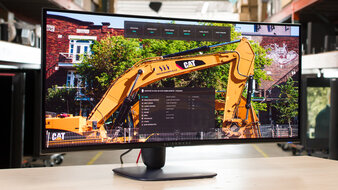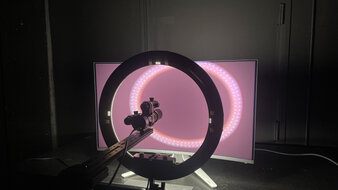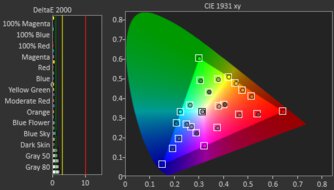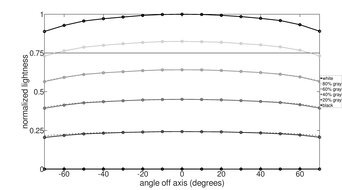Curved displays can be helpful for various usages, as the edges of the screen are brought closer to you compared to flat monitors, creating a more immersive experience. The curved monitor market has a bunch of different models available, and while many focus on gaming, there are some with productivity features. Many curved monitors have a 21:9 ultrawide aspect ratio, which provides more horizontal screen space than 16:9 monitors, but there are also curved 16:9 displays, including those with a 4k resolution for sharp images.
Even a monitor's curvature changes from model to model, and the curve radius defines the shape of the curve. A smaller number, like 800R, is more aggressive, while a 2500R curve is more subtle. We list the monitor's curve in each review as part of our extensive testing that includes nearly 400 tests. As there are so many different options available, there's no perfect solution for everyone, but considering your personal needs and budget is a good place to start. For example, you'll want a fast response time and good picture quality for gaming, while having high brightness and good reflection handling is useful for working in well-lit rooms.
We've bought and tested over 365 monitors, and below are our picks for the best curved monitors available to buy. Check out our recommendations for the best curved gaming monitors, the best ultrawide monitors, and the best 34-49 inch monitors.
Quick Look






Looking to save on your next monitor? We've got you covered! Check out our Early Black Friday 2025 Deals article to see what's worthwhile this year.
-
Best Curved Monitor
 PC Gaming9.0Office7.5SDR Picture10HDR Picture9.4Color Accuracy9.6Brightness6.8Response Time9.7Editing9.3Console Gaming9.0Size32"Pixel TypeQD-OLEDMax Refresh Rate240 HzNative Resolution3840 x 2160See all our test resultsCurve Radius1700R
PC Gaming9.0Office7.5SDR Picture10HDR Picture9.4Color Accuracy9.6Brightness6.8Response Time9.7Editing9.3Console Gaming9.0Size32"Pixel TypeQD-OLEDMax Refresh Rate240 HzNative Resolution3840 x 2160See all our test resultsCurve Radius1700RThe best curved monitor we've tested is the Dell Alienware AW3225QF. It's a premium 4k, 32-inch QD-OLED monitor that's focused on gaming. You can get it directly from Dell's website if you can't find it available through retailers. It provides outstanding gaming performance, and it provides a smooth and detailed gaming experience thanks to its high resolution and 240Hz refresh rate. It has a near-instantaneous response time, resulting in crisp motion, and it even has HDMI 2.1 bandwidth to take full advantage of modern graphics cards and gaming consoles.
In terms of picture quality, its QD-OLED panel makes it an incredible choice if you just want to sit back and watch HDR content. It has a near-infinite contrast ratio with deep and inky blacks in dark rooms, and it gets bright enough for highlights to pop. This monitor also displays a wide range of colors that look extremely vivid. One thing to note is that OLEDs risk permanent burn-in with constant exposure to the same static elements over time, and the black levels rise in bright rooms. This means it performs best in dark rooms, and you can reduce the risk of burn-in by using it for varied content.
-
Best Ultrawide Curved Monitor
 PC Gaming9.1Office6.9SDR Picture10HDR Picture9.4Color Accuracy9.4Brightness6.8Response Time9.8Editing9.0Console Gaming9.1Size34"Pixel TypeQD-OLEDMax Refresh Rate240 HzNative Resolution3440 x 1440See all our test resultsCurve Radius1800R
PC Gaming9.1Office6.9SDR Picture10HDR Picture9.4Color Accuracy9.4Brightness6.8Response Time9.8Editing9.0Console Gaming9.1Size34"Pixel TypeQD-OLEDMax Refresh Rate240 HzNative Resolution3440 x 1440See all our test resultsCurve Radius1800RIf you're looking for a high-end curved ultrawide display, then check out the 34-inch Dell Alienware AW3425DW, which you can get for a lower cost than the Dell Alienware AW3225QF. Its 21:9 aspect ratio offers a more immersive feel with more horizontal screen space, but it still has less total screen space than the AW3225QF. It also has a lower resolution than the AW3225QF, so images aren't as detailed. Because it's another QD-OLED, it has similar picture quality with deep and inky blacks in dark rooms, bright highlights, and vivid colors.
It also offers all the gaming benefits of an OLED, like a near-instantaneous response time for sharp motion, and its 240Hz refresh rate has a smooth feel. Like the AW3225QF, there are some downsides to getting this monitor, though. It doesn't get bright enough to fight intense glare, and reflections can be somewhat distracting because light bounces off light like a mirror. Blacks also look purple in bright rooms, and if that bothers you, you can check out the LG 34GS95QE-B instead. It's another OLED with the same deep blacks, but colors aren't as vivid.
-
Best Curved Monitor For Work
 PC Gaming6.3Office8.1SDR Picture7.5HDR Picture6.2Color Accuracy8.9Brightness7.7Response Time3.9Editing8.0Console Gaming5.8Size40"Pixel TypeIPSMax Refresh Rate120 HzNative Resolution5120 x 2160See all our test resultsCurve Radius2500R
PC Gaming6.3Office8.1SDR Picture7.5HDR Picture6.2Color Accuracy8.9Brightness7.7Response Time3.9Editing8.0Console Gaming5.8Size40"Pixel TypeIPSMax Refresh Rate120 HzNative Resolution5120 x 2160See all our test resultsCurve Radius2500RIf you want a curved monitor only for work, consider the Dell U4025QW. It has fewer gaming features and worse picture quality than both the Dell Alienware AW3225QF and the Dell Alienware AW3425DW, but these differences don't have a big impact on productivity. However, instead of high-end picture quality, it has a much bigger 40-inch screen with a 5k2k resolution and high pixel density, producing extremely sharp text. It has many productivity features that make it great for office use, and it doesn't risk permanent burn-in like the OLEDs, either.
Its massive USB hub includes five USB-C ports, and it supports Thunderbolt 4 and DisplayPort Alt Mode. These let you display an image from a compatible laptop and charge it with the same cable. It also has a few handy features, like Picture-in-Picture/Picture-by-Picture modes to display images from two sources simultaneously, and it even supports daisy chaining to another screen. There's also a KVM switch that makes it easy to switch between different sources and use the same keyboard and mouse, which is ideal for multitasking. If you don't need something so big and prefer saving money, check out the Dell U3425WE, but it has worse text clarity.
-
Best Mid-Range Curved Monitor
 PC Gaming7.6Office7.5SDR Picture7.9HDR Picture6.3Color Accuracy8.4Brightness7.7Response Time7.7Editing7.5Console Gaming7.3Size34"Pixel TypeVAMax Refresh Rate180 HzNative Resolution3440 x 1440See all our test resultsCurve Radius1500R
PC Gaming7.6Office7.5SDR Picture7.9HDR Picture6.3Color Accuracy8.4Brightness7.7Response Time7.7Editing7.5Console Gaming7.3Size34"Pixel TypeVAMax Refresh Rate180 HzNative Resolution3440 x 1440See all our test resultsCurve Radius1500RIf you don't have the budget for a premium monitor and you don't need a curved display only for work, then check out a mid-range option like the Dell Alienware AW3425DWM. It has the same 34-inch screen size as the Dell Alienware AW3425DW, so it offers an immersive feel, but it's a step down in a few performance aspects. It doesn't have a QD-OLED panel with the same perfect black levels in dark rooms, highlights that pop against the rest of the image, and vivid colors for a premium HDR experience. In fact, it's best to avoid using this monitor in HDR because it has a terrible edge-lit local dimming feature that automatically turns on in HDR, creating haloing around bright objects.
It has a lower 180Hz refresh rate than the AW3425DW, which is still good enough for most gamers. While it has consistent motion handling at any refresh rate, there's smearing with fast-moving objects. On the plus side, it's versatile if you need something for work and play as it doesn't risk burn-in like the AW3425DW, and it gets much brighter, which is great if you want to use it in a moderately lit room.
-
Best Budget Curved Monitor
 PC Gaming7.6Office7.4SDR Picture7.6HDR Picture6.4Color Accuracy8.5Brightness7.7Response Time7.8Editing7.4Console Gaming7.3Size32"Pixel TypeVAMax Refresh Rate180 HzNative Resolution2560 x 1440See all our test resultsCurve Radius1500R
PC Gaming7.6Office7.4SDR Picture7.6HDR Picture6.4Color Accuracy8.5Brightness7.7Response Time7.8Editing7.4Console Gaming7.3Size32"Pixel TypeVAMax Refresh Rate180 HzNative Resolution2560 x 1440See all our test resultsCurve Radius1500RIf you're looking for a curved monitor on a budget, there are some decent low-cost options you can get, like the Dell Alienware AW3225DM. It's a step-down model from the Dell Alienware AW3425DWM that you can get for a low cost directly from Dell's website. It has many of the same features as the higher-end AW3425DWM, though, and performs similarly, but it has a less immersive gaming experience for certain games, like atmospheric or sim racing, due to its narrower aspect ratio. However, it's still good for PC gaming thanks to its consistent motion handling, although it has black smearing with fast-moving objects. One downside is that it lacks HDMI 2.1 bandwidth to take full advantage of gaming consoles, but that's normal for an entry-level model.
Besides gaming, it's still a decent choice for office work because the 32-inch screen is big enough for some multitasking, and it has good text clarity. It also gets bright enough to fight glare, but reflections are distracting, so it's best to avoid placing it opposite a sunny window. Unfortunately, it has narrow viewing angles, so you get the most consistent image from sitting directly in front of it and not from the sides.
-
Best Cheap Curved Monitor
 PC Gaming6.9Office6.9SDR Picture7.7HDR Picture5.5Color Accuracy8.2Brightness5.8Response Time6.4Editing7.1Console Gaming6.3Size27"Pixel TypeVAMax Refresh Rate170 HzNative Resolution2560 x 1440See all our test resultsCurve Radius1500R
PC Gaming6.9Office6.9SDR Picture7.7HDR Picture5.5Color Accuracy8.2Brightness5.8Response Time6.4Editing7.1Console Gaming6.3Size27"Pixel TypeVAMax Refresh Rate170 HzNative Resolution2560 x 1440See all our test resultsCurve Radius1500RIf you need a simple and cheap curved monitor, there are a few decent options, although most have a 16:9 aspect ratio, so they aren't ultrawides. If you're interested in that, the Gigabyte GS27QC is a decent choice that works well for gaming. It's a step down in overall performance compared to the Dell Alienware AW3225DM because it doesn't get nearly as bright, so it's better to use it in a dark room, as it displays deep blacks next to bright highlights.
Besides that, it has a max 170Hz refresh rate that you can achieve over a DisplayPort connection, but like the Dell, fast-moving objects look blurry and have smearing behind them. Unfortunately, the monitor isn't very versatile for other uses as it has narrow viewing angles, but this is the case for most curved entry-level displays anyway. It also has terrible ergonomics, so you may want to consider getting a third-party stand or mount if you want to adjust the screen often. On the plus side, its 27-inch screen means it has higher pixel density than the Dell and text looks sharp.
Notable Mentions
-
LG 40WP95C-W:
The LG 40WP95C-W is a productivity monitor with a 40-inch, 5k2k screen like the Dell U4025QW and tends to cost less. It's a good option for work, but it has fewer features than the Dell, as it has a smaller USB hub.
See our review -
Samsung Odyssey OLED G9/G95SC S49CG95:
The Samsung Odyssey OLED G9/G95SC S49CG95 is a super ultrawide QD-OLED monitor with a 49-inch screen. Consider this if you want a bigger screen than the Dell Alienware AW3425DW, but its large size may not be ideal for everyone.
See our review -
MSI MPG 341CQPX QD-OLED:
The MSI MPG 341CQPX QD-OLED is an ultrawide monitor with similar picture quality to the Dell Alienware AW3425DW thanks to its QD-OLED panel. It also has extra productivity features, like a KVM switch, but it's more expensive.
See our review -
Samsung Odyssey Neo G8 S32BG85:
The Samsung Odyssey Neo G8 S32BG85 is a high-end 4k, 240Hz monitor. It's an alternative to the Dell Alienware AW3225QF if you don't want an OLED, as it uses Mini LED backlighting, but that means its picture quality is worse than the Dell.
See our review
Recent Updates
Sep 02, 2025:
We replaced the LG 34GS95QE-B with the Dell Alienware AW3425DW because the Dell has better picture quality. We also added the Dell Alienware AW3425DWM and replaced the Dell S3422DWG with the Dell Alienware AW3225DM to better represent the current market.
May 01, 2025:
We replaced the MSI MPG 341CQPX QD-OLED with the LG 34GS95QE-B, as the MSI is harder to find. We also removed the Corsair XENEON FLEX 45WQHD240 from the Notable Mentions and added the 341CQPX and the Samsung Odyssey Neo G8 S32BG85 as Notable Mentions.
Feb 19, 2025:
We introduced a new format to the article and updated the text to reflect these changes.
Nov 28, 2024:
We replaced the Dell Alienware AW3423DWF with the MSI MPG 341CQPX QD-OLED because it has a higher refresh rate and more features.
Sep 06, 2024: We replaced the MSI MEG 342C QD-OLED with the LG 34GS95QE-B in the Notable Mentions because the MSI is hard to find.
All Reviews
Our recommendations are based on what we think are the best monitors with a curved screen currently available. They're adapted to be valid for most people in each price range. The rating is based on our review, factoring in price and feedback from our visitors.
If you'd prefer to make your own decision, here's the list of all the curved monitors we've tested. Be careful not to get too caught up in the details. Most monitors are good enough to please most people, and the things we fault monitors on are often not noticeable unless you really look for them.



















